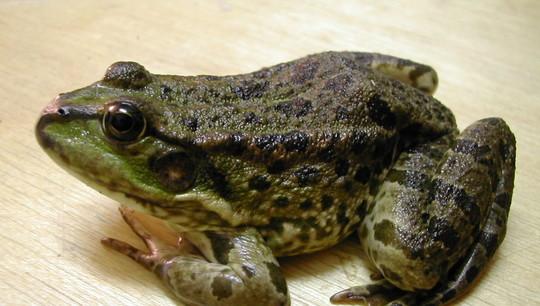Scientists are studying how genome protects itself from foreign DNA

Credit: Vladimir Vershinin
Biologists have found that lake frogs of the same “appearance” have different mitochondrial DNA. Such heterogeneous genetics probably helps to better adapt to the environmental conditions.
‘It turns out that among the lake frog (this is a single population) there are different forms, which are sometimes called cryptic species. They are twin species, indistinguishable by external features, but differing genetically,’ explains Vladimir Vershinin, professor of Biodiversity and Bioecology at Institute of Natural Sciences and Mathematics, Ural Federal University, head of laboratory of Functional Ecology of Land Animals of the Institute of Plant and Animal Ecology UB RAS. ‘They are quite difficult to recognize by morphology, but they are very diverse. In addition, traces of their ancestors’ history were found in their genomes: the fact that their ancestors interbred with other species and other forms.’
The frogs of the Middle Ural have more diverse DNA than, for example, the frogs of the Nizhny Novgorod region. According to Mr. Vershinin, frogs with Balkan, European and Asian “roots” are found in our waters.
‘The frogs were brought in as laboratory animals. And then the practicum ended, living material remained, and they were released. Since the city has warm waters, they naturalized,’ the biologist says. ‘In addition, tadpoles were brought to us for fisheries. From the southern regions, Krasnodar region, from Ukraine. And all of it ended up in the waters. There are also unidentified sources that we still have to figure out.’
The biologists of UrFU Institute of Natural Sciences and Mathematics conducted their research in collaboration with Japanese colleagues from the Amphibian Research Center (Hiroshima University). With the support of the Russian Foundation for Basic Research grant, they want to study the hybridogenesis and DNA elimination, to understand how the genome is protected from foreign DNA.
‘We have elicited the fact that the Ural frogs have different genetics as a result of one of the grant research directions,’ Vladimir Vershinin explains. ‘When two species hybridize, the genome of the offspring includes 50% of one species and 50% of the other. But when these hybrids begin to multiply, they form sex cells (gametes) of only one species. And during gametogenesis the genome of one of the parental species is destroyed, eliminated. What determines which of the two will be eliminated is unknown. Hybrids can produce gametes of one or the other of the original species. Finding the factors that determine which genome will be eliminated during gametogenesis is the essence of the large-scale study.’
The first scientific results will be published in an article in the journal Genetics and presented at a scientific conference to be held at UrFU in September.
###
Media Contact
Inna Mikhaydarova
[email protected]
Original Source
https:/




